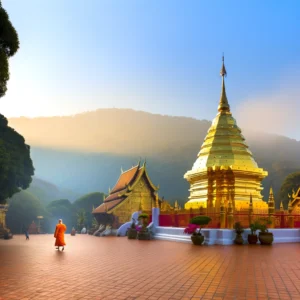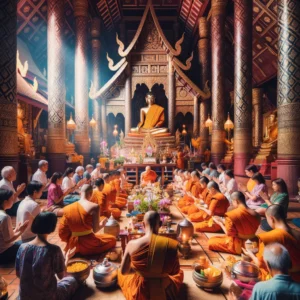Introduction
Chiang Mai, the heart of Northern Thailand, is a city where history whispers from every corner, especially through its ancient temples. With over 300 wats dotting the landscape, each temple offers a unique glimpse into the spiritual and architectural heritage of the Lanna Kingdom. This journey through Chiang Mai’s temple trail is not just a tour; it’s a voyage back in time and an exploration of serenity amidst the city’s modern bustle.

The Historical Heart of Chiang Mai: Wat Phra That Doi Suthep
Wat Phra That Doi Suthep is arguably Chiang Mai’s most sacred temple, perched high on a mountain and offering breathtaking views over the city. Legend has it that the temple was founded to house a piece of bone from the Buddha, which the white elephant carrying it chose as its final resting place. The temple’s golden chedi, a beacon of spirituality, and the naga staircase leading up to it, are emblematic of the temple’s mystique and its significance in Thai Buddhism.

Exploring Wat Chedi Luang: The Temple of the Great Stupa
Wat Chedi Luang, once home to the Emerald Buddha, now stands as a monument to the architectural prowess of the Lanna Kingdom. Its massive chedi, partially restored after a 16th-century earthquake, dominates the Chiang Mai skyline, serving as a beacon of historical and religious significance. This temple was the center of religious life in Chiang Mai, hosting important Buddhist ceremonies and serving as a site for royal rituals.

The grounds of Wat Chedi Luang are a testament to the city’s spiritual and cultural heritage, inviting visitors to wander among the ancient ruins and reflect on the centuries of devotion they represent.
Wat Phra Singh: The Temple of the Lion Buddha
Wat Phra Singh, housing the revered Phra Singh Buddha image, is a cornerstone of Chiang Mai’s religious and cultural life. The temple complex, adorned with intricate Lanna art and architecture, offers a tranquil retreat in the heart of the old city. During Songkran and other Buddhist festivals, Wat Phra Singh becomes a focal point for celebrations, drawing both locals and tourists to participate in its ancient rituals.
The temple’s halls and libraries are richly decorated, housing a collection of Lanna artifacts and scriptures that offer insights into Northern Thailand’s Buddhist traditions. The serene atmosphere of Wat Phra Singh’s courtyards and gardens provides a space for meditation and contemplation amidst the city’s bustling activity.
Wat Suan Dok: The Flower Garden Temple
Wat Suan Dok, with its distinctive open-air viharn and large golden chedi, is a serene haven just outside the city center. This temple, which translates to “flower garden temple,” was originally built in the 14th century on the grounds of a royal pleasure garden. It is renowned for its white stupas that house the ashes of Chiang Mai’s royal family, creating a striking contrast against the lush greenery.

The temple’s spacious grounds and tranquil atmosphere make it an ideal spot for meditation and contemplation, inviting visitors to explore its rich history and architectural beauty.
Off the Beaten Path: Discovering Lesser-Known Temples
Chiang Mai’s temple trail extends beyond its most famous sites, offering adventurers the chance to explore lesser-known temples that dot the landscape. These hidden gems provide a quieter, more intimate experience of the city’s spiritual heritage, often featuring unique art, architecture, and serene environments perfect for personal reflection.
Temples like Wat Umong, set in a forest and known for its ancient tunnels and Buddha images, or Wat Jed Yod, with its seven spires symbolizing the seven weeks Buddha spent contemplating his enlightenment, offer unique insights into Lanna culture and Buddhist philosophy.
Seeking out these quieter sanctuaries allows for a deeper connection to Chiang Mai’s ancient traditions and the peace that these sacred spaces offer.
The Spiritual Experience: Participating in Temple Rituals
Chiang Mai’s temples offer more than just visual splendor; they invite visitors to immerse themselves in Buddhist traditions and practices. Engaging in temple rituals, such as making merit through offerings to monks, participating in meditation sessions, or attending traditional ceremonies, provides a profound opportunity for cultural immersion and spiritual growth.

These experiences allow visitors to connect with the essence of Buddhism and gain insights into the spiritual life that permeates Chiang Mai and its people.
Conclusion
Traversing Chiang Mai’s temple trail is more than a historical journey; it’s an exploration of spiritual serenity and architectural beauty. Each temple, from the well-trodden paths of Wat Phra That Doi Suthep to the tranquil grounds of lesser-known wats, tells a story of faith, culture, and community. This journey offers a unique lens through which to view the soul of Chiang Mai, inviting personal reflection and a deeper understanding of Northern Thailand’s spiritual heritage.
Have you walked the temple trail in Chiang Mai? Share your experiences, favorite temples, or any spiritual insights you’ve gained along the way. Your stories can inspire others to embark on their own journey through Chiang Mai’s sacred spaces, exploring the beauty and tranquility that these temples offer.